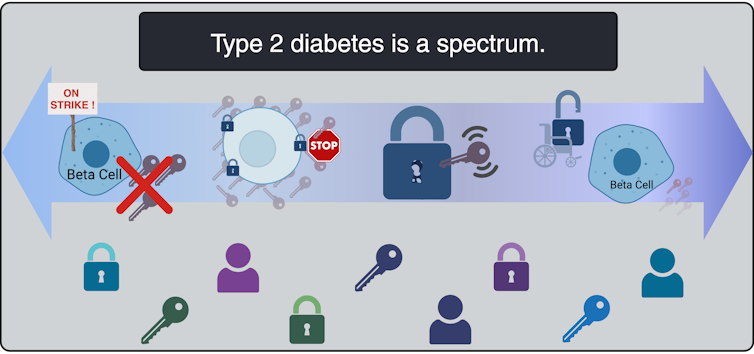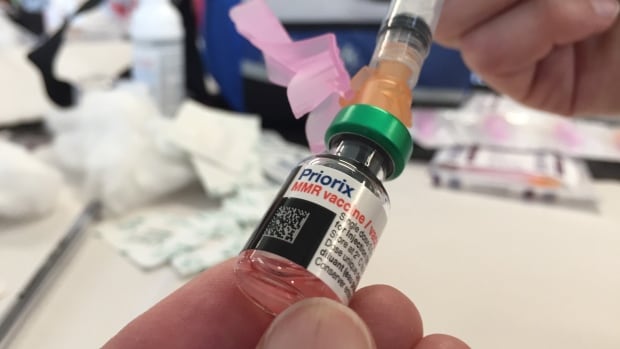Health
‘I hate this’: Saskatoon patient stuck in hospital for eight months, with no end in sight – Global News
An earlier version of this story said Cory had been in hospital since July 2022 for a total of seven months. He’s been in hospital since June 2022 for a total of eight months.
Cory Kadlec has been in hospital so long, his family said, his health isn’t getting better, it’s getting worse.
He’s been in a hospital in Saskatoon since June 11, 2022, after he had a seizure, according to his sister Tara Jo.
She told Global News Cory has Down Syndrome, diabetes, celiac disease, Stage 2 dementia, a thyroid issue and suffered a stroke in 2020.
Cory and his family say the long hospital stay is hurting his recovery. He can’t spend time with friends and live the independent life he is capable of living. They said his mental health is deteriorating.
Cory wants to return to a care home, like one he lived at before he had the seizure. But care homes said they can’t accommodate Cory’s complex health needs, the family says.
According to his family, the only option the Saskatchewan Health Authority (SHA) and Ministry of Social Services (MSS) offered is even worse – a long-term care dementia ward.
‘There’s no way my brother will survive in there mentally,” Tara Jo said, speaking from her home in Calgary. “Not one minute.”
She said the other patients in the long-term care (LTC) facility have late-stage dementia that is much worse than Cory’s early-stage affliction.

According to the Alzheimer’s Society of Canada, patients with early-stage dementia can have difficulties communicating and forget things but “retain many of their abilities” whereas people with mid- and late-stage dementia may require “(a)ssistance with daily tasks,” such as dressing and using the bathroom, and can require care 24 hours a day.
Tara Jo said Cory does need access to round-the-clock care, but not for his dementia. Rather, for his diabetes, which can require several doses of different types of insulin every day.
She said putting Cory in the LTC would mean he is isolated and wouldn’t be capable of enjoying his life.
Cory Kadlec says he hates waiting in the hospital. He wants to go back to a group home but his family says the Saskatchewan Health Authority won’t provide the medical support he needs.
Tara Jo Kadlec / Supplied
“He actually needs an appropriate home for his medical needs as well as what he deserves as a human to live the life that he still has,” she said.
She told Global News Cory wants a room of his own where he can still be independent.
Tara Jo, who is Cory’s legal guardian along with their father, said only two care homes contacted the family and both said they are unable to accept Cory because they can’t accommodate his medical needs.
The Saskatchewan Ministry of Social Services provides funding through partnerships with many care homes across the province, including group homes, group living homes and day programs.
Tara Jo said she was told repeatedly by SHA and MSS officials that the SHA must fund medical care administered in group homes.
Tara Jo said she had hoped the Ministry and Authority would work together to help Cory.
“They said the only option we’re giving you is long-term care,” she said.
Global News asked Elmwood Residences Inc., the Saskatoon-based organization that operates the care home where Cory was living prior to suffering the seizure, for an interview.
Rachael Steinke, the executive director, provided a statement in which she specified confidentiality prohibited her from speaking about specifics of Cory’s case.
“Elmwood recognizes and experiences gaps between human service systems where one Ministry or Authority ends, and another begins,” she wrote.
The statement also said “(l)ong standing funding issues for Community-Based Organizations in the Disability Service Sector and provincial recruitment initiatives for the Health and Education sectors widen the gaps and cause significant recruitment and retention issues.”
“It is Elmwood’s deep hope that the service gaps are recognized and addressed to ensure all individuals with intellectual disabilities have their needs met seamlessly and without delay.”

Tara Jo told Global News MSS did offer to pay for a support worker for 40 hours a week. She said it helps but 40 hours isn’t enough.
She also said the family sought to have MSS re-evaluate Cory after his stroke to see if he qualified for more benefits. She said officials told the family they won’t re-evaluate him until he’s stabilized from the stroke – which Tara Jo said can’t happen while he’s in hospital.
She said the family can’t afford to pay for Cory’s care and they’re unable to care for him themselves because they lack the training and don’t all live in Saskatchewan.
Tara Jo said they’d consider moving him to Alberta, but Alberta officials told her they need to evaluate Cory in that province – which would require the family to move Cory and care for him while they wait for the evaluation process and housing to become available.
Bluesette Campbell, the president of Inclusion Saskatchewan, an organization that works to support individuals with intellectual disabilities, said she’s heard of many people waiting a long time for appropriate housing.
Cory Kadlec in a Saskatoon hospital. His family told Global News they brought him many of his things from his group home so he would be more comfortable.
Tara Jo Kadlec
Speaking generally about the support available, she said the system is reactive, “which is… you have to sit there and wait. I don’t find that acceptable.”
Part of the problem is a lack of housing across all sectors, she said.
She also said the division of responsibility between ministries can contribute to inadequate care.
“What we recognize is this… cross-section or cross-cutting of responsibilities that don’t necessarily fall neat and tidy into one silo,” she said.
She said any solution must involve speaking to people with intellectual disabilities and asking what they want.
“I believe that everyone, regardless of their age or their abilities, has that right to have a place where they are safe and feel (at) home.”
When asked about his time in the hospital in an interview, Cory told Global News, “I hate this.”
Bob Martinook, the executive director of the social service ministry’s community living service delivery, in a statement said “we want Cory Kadlec and his family to know we understand their concerns and are here as a support.”
The statement said the ministry couldn’t speak to specific cases due to privacy concerns, but did say planning is an ongoing process with regular reviews to ensure appropriate supports are being provided.
David Freeman, an SHA media relations specialist, also cited privacy and would not speak about Cory’s situation.
His statement said the Health Authority weighs all patient care needs and best matches the individual’s needs – both medical and social, in the case of long-term care or community living placement – with the care options available.”
“We take all care concerns from patients and their family members very seriously.”
Tara Jo said she doesn’t know how to get Cory the care he needs. For now, it appears he’s stuck in the hospital.
“I feel broken. My family feels broken, but most of all, my brother is broken,” Tara Jo said.
Health
Cancer Awareness Month – Métis Nation of Alberta


Cancer Awareness Month
Posted on: Apr 18, 2024
April is Cancer Awareness Month
As we recognize Cancer Awareness Month, we stand together to raise awareness, support those affected, advocate for prevention, early detection, and continued research towards a cure. Cancer is the leading cause of death for Métis women and the second leading cause of death for Métis men. The Otipemisiwak Métis Government of the Métis Nation Within Alberta is working hard to ensure that available supports for Métis Citizens battling cancer are culturally appropriate, comprehensive, and accessible by Métis Albertans at all stages of their cancer journey.
Receiving a cancer diagnosis, whether for yourself or a loved one, can feel overwhelming, leaving you unsure of where to turn for support. In June, our government will be launching the Cancer Supports and Navigation Program which will further support Métis Albertans and their families experiencing cancer by connecting them to OMG-specific cancer resources, external resources, and providing navigation support through the health care system. This program will also include Métis-specific peer support groups for those affected by cancer.
With funding from the Canadian Partnership Against Cancer (CPAC) we have also developed the Métis Cancer Care Course to ensure that Métis Albertans have access to culturally safe and appropriate cancer services. This course is available to cancer care professionals across the country and provides an overview of who Métis people are, our culture, our approaches to health and wellbeing, our experiences with cancer care, and our cancer journey.
Together, we can make a difference in the fight against cancer and ensure equitable access to culturally safe and appropriate care for all Métis Albertans. Please click on the links below to learn more about the supports available for Métis Albertans, including our Compassionate Care: Cancer Transportation program.
I wish you all good health and happiness!
Bobbi Paul-Alook
Secretary of Health & Seniors
Health
Type 2 diabetes is not one-size-fits-all: Subtypes affect complications and treatment options – The Conversation


You may have heard of Ozempic, the “miracle drug” for weight loss, but did you know that it was actually designed as a new treatment to manage diabetes? In Canada, diabetes affects approximately 10 per cent of the general population. Of those cases, 90 per cent have Type 2 diabetes.
This metabolic disorder is characterized by persistent high blood sugar levels, which can be accompanied by secondary health challenges, including a higher risk of stroke and kidney disease.
Locks and keys
In Type 2 diabetes, the body struggles to maintain blood sugar levels in an acceptable range. Every cell in the body needs sugar as an energy source, but too much sugar can be toxic to cells. This equilibrium needs to be tightly controlled and is regulated by a lock and key system.
In the body’s attempt to manage blood sugar levels and ensure that cells receive the right amount of energy, the pancreatic hormone, insulin, functions like a key. Cells cover themselves with locks that respond perfectly to insulin keys to facilitate the entry of sugar into cells.
Unfortunately, this lock and key system doesn’t always perform as expected. The body can encounter difficulties producing an adequate number of insulin keys, and/or the locks can become stubborn and unresponsive to insulin.
All forms of diabetes share the challenge of high blood sugar levels; however, diabetes is not a singular condition; it exists as a spectrum. Although diabetes is broadly categorized into two main types, Type 1 and Type 2, each presents a diversity of subtypes, especially Type 2 diabetes.
These subtypes carry their own characteristics and risks, and do not respond uniformly to the same treatments.
To better serve people living with Type 2 diabetes, and to move away from a “one size fits all” approach, it is beneficial to understand which subtype of Type 2 diabetes a person lives with. When someone needs a blood transfusion, the medical team needs to know the patient’s blood type. It should be the same for diabetes so a tailored and effective game plan can be implemented.
This article explores four unique subtypes of Type 2 diabetes, shedding light on their causes, complications and some of their specific treatment avenues.
Severe insulin-deficient diabetes: We’re missing keys!
(Lili Grieco-St-Pierre, Jennifer Bruin/Created with BioRender.com)
Insulin is produced by beta cells, which are found in the pancreas. In the severe insulin-deficient diabetes (SIDD) subtype, the key factories — the beta cells — are on strike. Ultimately, there are fewer keys in the body to unlock the cells and allow entry of sugar from the blood.
SIDD primarily affects younger, leaner individuals, and unfortunately, increases the risk of eye disease and blindness, among other complications. Why the beta cells go on strike remains largely unknown, but since there is an insulin deficiency, treatment often involves insulin injections.
Severe insulin-resistant diabetes: But it’s always locked!

(Lili Grieco-St-Pierre, Jennifer Bruin/Created with BioRender.com)
In the severe insulin-resistant diabetes (SIRD) subtype, the locks are overstimulated and start ignoring the keys. As a result, the beta cells produce even more keys to compensate. This can be measured as high levels of insulin in the blood, also known as hyperinsulinemia.
This resistance to insulin is particularly prominent in individuals with higher body weight. Patients with SIRD have an increased risk of complications such as fatty liver disease. There are many treatment avenues for these patients but no consensus about the optimal approach; patients often require high doses of insulin.
Mild obesity-related diabetes: The locks are sticky!

(Lili Grieco-St-Pierre, Jennifer Bruin/Created with BioRender.com)
Mild obesity-related (MOD) diabetes represents a nuanced aspect of Type 2 diabetes, often observed in individuals with higher body weight. Unlike more severe subtypes, MOD is characterized by a more measured response to insulin. The locks are “sticky,” so it is challenging for the key to click in place and open the lock. While MOD is connected to body weight, the comparatively less severe nature of MOD distinguishes it from other diabetes subtypes.
To minimize complications, treatment should include maintaining a healthy diet, managing body weight, and incorporating as much aerobic exercise as possible. This is where drugs like Ozempic can be prescribed to control the evolution of the disease, in part by managing body weight.
Mild age-related diabetes: I’m tired of controlling blood sugar!

(Lili Grieco-St-Pierre, Jennifer Bruin/Created with BioRender.com)
Mild age-related diabetes (MARD) happens more often in older people and typically starts later in life. With time, the key factory is not as productive, and the locks become stubborn. People with MARD find it tricky to manage their blood sugar, but it usually doesn’t lead to severe complications.
Among the different subtypes of diabetes, MARD is the most common.
Unique locks, varied keys
While efforts have been made to classify diabetes subtypes, new subtypes are still being identified, making proper clinical assessment and treatment plans challenging.
In Canada, unique cases of Type 2 diabetes were identified in Indigenous children from Northern Manitoba and Northwestern Ontario by Dr. Heather Dean and colleagues in the 1980s and 90s. Despite initial skepticism from the scientific community, which typically associated Type 2 diabetes with adults rather than children, clinical teams persisted in identifying this as a distinct subtype of Type 2 diabetes, called childhood-onset Type 2 diabetes.
Read more:
Indigenous community research partnerships can help address health inequities
Childhood-onset Type 2 diabetes is on the rise across Canada, but disproportionately affects Indigenous youth. It is undoubtedly linked to the intergenerational trauma associated with colonization in these communities. While many factors are likely involved, recent studies have discovered that exposure of a fetus to Type 2 diabetes during pregnancy increases the risk that the baby will develop diabetes later in life.
Acknowledging this distinct subtype of Type 2 diabetes in First Nations communities has led to the implementation of a community-based health action plan aimed at addressing the unique challenges faced by Indigenous Peoples. It is hoped that partnered research between communities and researchers will continue to help us understand childhood-onset Type 2 diabetes and how to effectively prevent and treat it.
A mosaic of conditions

(Lili Grieco-St-Pierre, Jennifer Bruin/Created with BioRender.com)
Type 2 diabetes is not uniform; it’s a mosaic of conditions, each with its own characteristics. Since diabetes presents so uniquely in every patient, even categorizing into subtypes does not guarantee how the disease will evolve. However, understanding these subtypes is a good starting point to help doctors create personalized plans for people living with the condition.
While Indigenous communities, lower-income households and individuals living with obesity already face a higher risk of developing Type 2 diabetes than the general population, tailored solutions may offer hope for better management. This emphasizes the urgent need for more precise assessments of diabetes subtypes to help customize therapeutic strategies and management strategies. This will improve care for all patients, including those from vulnerable and understudied populations.
Health
Quebec successfully pushes back against rise in measles cases – CBC.ca


Quebec appears to be winning its battle against the rising tide of measles after 45 cases were confirmed province-wide this year.
“We’ve had no locally transmitted measles cases since March 25, so that’s good news,” said Dr. Paul Le Guerrier, responsible for immunization for Montreal Public Health.
There are 17 patients with measles in Quebec currently, and the most recent case is somebody who was infected while abroad, he said.
But it was no small task to get to this point.
Le Guerrier said once local transmission was detected, news was spread fast among health centres to ensure proper protocols were followed — such as not letting potentially infected people sit in waiting rooms for hours on end.
Then about 90 staffers were put to work, tracking down those who were in contact with positive cases and are not properly vaccinated. They were given post-exposure prophylaxis, which prevents disease, said Le Guerrier.
From there, a vaccination campaign was launched, especially in daycares, schools and neighbourhoods with low inoculation rates. There was an effort to convince parents to get their children vaccinated.
Vaccination in schools boosted
Some schools, mostly in Montreal, had vaccination rates as low as 30 or 40 per cent.
“Vaccination was well accepted and parents responded well,” said Le Guerrier. “Some schools went from very low to as high as 85 to 90 per cent vaccination coverage.”
But it’s not only children who aren’t properly vaccinated. Le Guerrier said people need two doses after age one to be fully inoculated, and he encouraged people to check their status.
There are all kinds of reasons why people aren’t vaccinated, but it’s only about five per cent who are against immunization, he said. So far, some 10,000 people have been vaccinated against measles province-wide during this campaign, Le Guerrier said.
The next step is to continue pushing for further vaccination, but he said, small outbreaks are likely in the future as measles is spreading abroad and travellers are likely to bring it back with them.
Need to improve vaccination rate, expert says
Dr. Donald Vinh, an infectious diseases specialist from the McGill University Health Centre, said it’s not time to rest on our laurels, but this is a good indication that public health is able to take action quickly and that people are willing to listen to health recommendations.
“We are not seeing new cases or at least the new cases are not exceeding the number of cases that we can handle,” said Vinh.
“So these are all reassuring signs, but I don’t think it’s a sign that we need to become complacent.”
Vinh said there are also signs that the public is lagging in vaccine coverage and it’s important to respond to this with improved education and access. Otherwise, microbes capitalize on our weaknesses, he said.
Getting vaccination coverage up to an adequate level is necessary, Vinh said, or more small outbreaks like this will continue to happen.
“And it’s very possible that we may not be able to get one under control if we don’t react quickly enough,” he said.
-



 Science10 hours ago
Science10 hours agoJeremy Hansen – The Canadian Encyclopedia
-



 Investment10 hours ago
Investment10 hours agoUK Mulls New Curbs on Outbound Investment Over Security Risks – BNN Bloomberg
-



 Tech9 hours ago
Tech9 hours agoSave $700 Off This 4K Projector at Amazon While You Still Can – CNET
-



 Tech8 hours ago
Tech8 hours ago'Kingdom Come: Deliverance II' Revealed In Epic New Trailer And It Looks Incredible – Forbes
-



 Sports8 hours ago
Sports8 hours agoAuston Matthews denied 70th goal as depleted Leafs lose last regular-season game – Toronto Sun
-
Real eState9 hours ago
Sick of Your Blue State? These Real Estate Agents Have Just the Place for You. – The New York Times
-



 Health24 hours ago
Health24 hours agoSupervised consumption sites urgently needed, says study – Sudbury.com
-
News23 hours ago
Canada's 2024 budget announces 'halal mortgages'. Here's what to know – National Post







